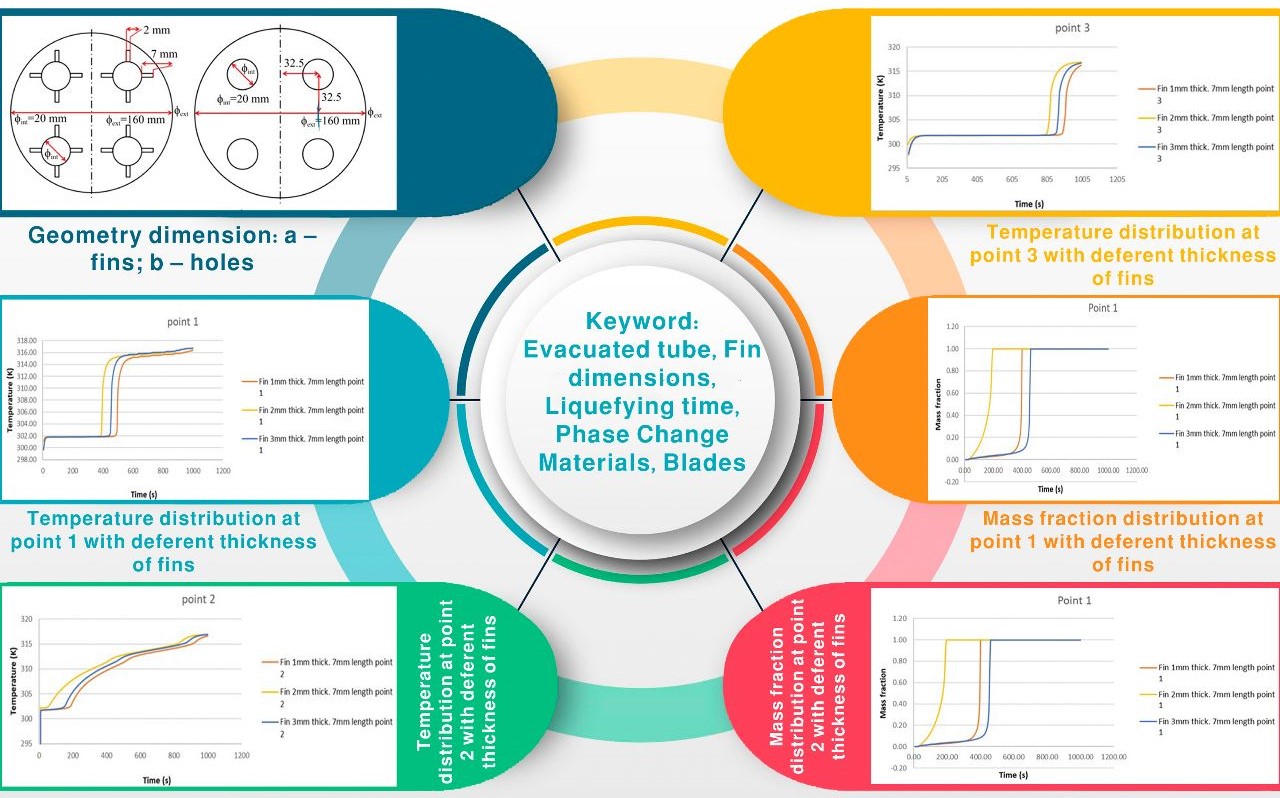Чисельний аналіз розподілу температури і масової долі вакуумної труби з використанням зміни фаз
DOI:
https://doi.org/10.15587/1729-4061.2022.268288Ключові слова:
Вакуумна труба, розміри ребра, час розрідження, матеріали з фазовим переходом, лопатіАнотація
З просуванням екологічно чистих енергетичних інновацій та використанням матеріалів із фазовим переходом в обслуговуванні ядерної енергетики важливо було спробувати й надалі розвивати інтенсивність руху матеріалів, що еволюціонують на стадії.
Відтворення 2D CFD було виконано для імітації системи пом’якшення матеріалу з фазовим переходом, який заповнює круглу та порожнисту яму, яка включає джерела нагріву. Модель CFD у світлі фактичного рівняння ентальпії використовувалася для відтворення фазового переходу сильного галію та для математичного розрахунку часу джерел нагріву відповідно до робочих умов щодо застосовуваних температур. Математичне вплив джерел потепління, і навіть граничні умови для теплопередачі атрибути підлягають вичерпному аналізу.
Пристрій з противагами покращує теплопередачу та додатково збільшує час розрідження матеріалів з фазовим переходом. Теорія поширення тепла в ребрі заснована на тому факті, що температура підвищується та знижується залежно від довжини ребра. Температура досягає 316 K за час 300 секунд, що на 100 секунд менше, ніж коли плавець коротше на 7 мм.
Найкращий випадок для ребра довжиною 14 мм — найкращий випадок порівняно з рештою.
Де були використані Чотириразові теплі леза охоплюють трубу інтенсивності двох довжин: 14 мм і 7 мм з різною товщиною 1, 2, 3 мм, і оцінка математично оцінюється для кількох явних фокусів, розташованих усередині зосереджених розробок, що визначають наслідки капітального ремонту джерел тепла.
По суті, температурний розвиток та рідинна частина працюють на основні моменти зосереджених розробок, які являють собою круглі та порожнисті джерела нагріву та оребрені гарячі точки нагріву для доданої температури (Th=40 °C) доданої температури
Посилання
- Bouhal, T., ed-Dîn Fertahi, S., Kousksou, T., Jamil, A. (2018). CFD thermal energy storage enhancement of PCM filling a cylindrical cavity equipped with submerged heating sources. Journal of Energy Storage, 18, 360–370. doi: https://doi.org/10.1016/j.est.2018.05.015
- Olfian, H., Ajarostaghi, S. S. M., Farhadi, M., Ramiar, A. (2021). Melting and solidification processes of phase change material in evacuated tube solar collector with U-shaped spirally corrugated tube. Applied Thermal Engineering, 182, 116149. doi: https://doi.org/10.1016/j.applthermaleng.2020.116149
- Kabeel, A. E., Abdelgaied, M. (2018). Solar energy assisted desiccant air conditioning system with PCM as a thermal storage medium. Renewable Energy, 122, 632–642. doi: https://doi.org/10.1016/j.renene.2018.02.020
- Sansaniwal, S. K., Sharma, V., Mathur, J. (2018). Energy and exergy analyses of various typical solar energy applications: A comprehensive review. Renewable and Sustainable Energy Reviews, 82, 1576–1601. doi: https://doi.org/10.1016/j.rser.2017.07.003
- Xu, F., Bian, Z. F., Ge, T. S., Dai, Y. J., Wang, C. H., Kawi, S. (2019). Analysis on solar energy powered cooling system based on desiccant coated heat exchanger using metal-organic framework. Energy, 177, 211–221. doi: https://doi.org/10.1016/j.energy.2019.04.090
- Solano–Olivares, K., Romero, R. J., Santoyo, E., Herrera, I., Galindo–Luna, Y. R., Rodríguez–Martínez, A. et al. (2019). Life cycle assessment of a solar absorption air-conditioning system. Journal of Cleaner Production, 240, 118206. doi: https://doi.org/10.1016/j.jclepro.2019.118206
- Novaes Pires Leite, G. de, Weschenfelder, F., Araújo, A. M., Villa Ochoa, Á. A., Franca Prestrelo Neto, N. da, Kraj, A. (2019). An economic analysis of the integration between air-conditioning and solar photovoltaic systems. Energy Conversion and Management, 185, 836–849. doi: https://doi.org/10.1016/j.enconman.2019.02.037
- Rahman, S., Issa, S., Said, Z., El Haj Assad, M., Zadeh, R., Barani, Y. (2019). Performance enhancement of a solar powered air conditioning system using passive techniques and SWCNT /R-407c nano refrigerant. Case Studies in Thermal Engineering, 16, 100565. doi: https://doi.org/10.1016/j.csite.2019.100565
- Jani, D. B., Mishra, M., Sahoo, P. K. (2018). A critical review on application of solar energy as renewable regeneration heat source in solid desiccant – vapor compression hybrid cooling system. Journal of Building Engineering, 18, 107–124. doi: https://doi.org/10.1016/j.jobe.2018.03.012
- Opoku, R., Mensah-Darkwa, K., Samed Muntaka, A. (2018). Techno-economic analysis of a hybrid solar PV-grid powered air-conditioner for daytime office use in hot humid climates – A case study in Kumasi city, Ghana. Solar Energy, 165, 65–74. doi: https://doi.org/10.1016/j.solener.2018.03.013

##submission.downloads##
Опубліковано
Як цитувати
Номер
Розділ
Ліцензія
Авторське право (c) 2022 Ahmed Kareem Khudhair

Ця робота ліцензується відповідно до Creative Commons Attribution 4.0 International License.
Закріплення та умови передачі авторських прав (ідентифікація авторства) здійснюється у Ліцензійному договорі. Зокрема, автори залишають за собою право на авторство свого рукопису та передають журналу право першої публікації цієї роботи на умовах ліцензії Creative Commons CC BY. При цьому вони мають право укладати самостійно додаткові угоди, що стосуються неексклюзивного поширення роботи у тому вигляді, в якому вона була опублікована цим журналом, але за умови збереження посилання на першу публікацію статті в цьому журналі.
Ліцензійний договір – це документ, в якому автор гарантує, що володіє усіма авторськими правами на твір (рукопис, статтю, тощо).
Автори, підписуючи Ліцензійний договір з ПП «ТЕХНОЛОГІЧНИЙ ЦЕНТР», мають усі права на подальше використання свого твору за умови посилання на наше видання, в якому твір опублікований. Відповідно до умов Ліцензійного договору, Видавець ПП «ТЕХНОЛОГІЧНИЙ ЦЕНТР» не забирає ваші авторські права та отримує від авторів дозвіл на використання та розповсюдження публікації через світові наукові ресурси (власні електронні ресурси, наукометричні бази даних, репозитарії, бібліотеки тощо).
За відсутності підписаного Ліцензійного договору або за відсутністю вказаних в цьому договорі ідентифікаторів, що дають змогу ідентифікувати особу автора, редакція не має права працювати з рукописом.
Важливо пам’ятати, що існує і інший тип угоди між авторами та видавцями – коли авторські права передаються від авторів до видавця. В такому разі автори втрачають права власності на свій твір та не можуть його використовувати в будь-який спосіб.










